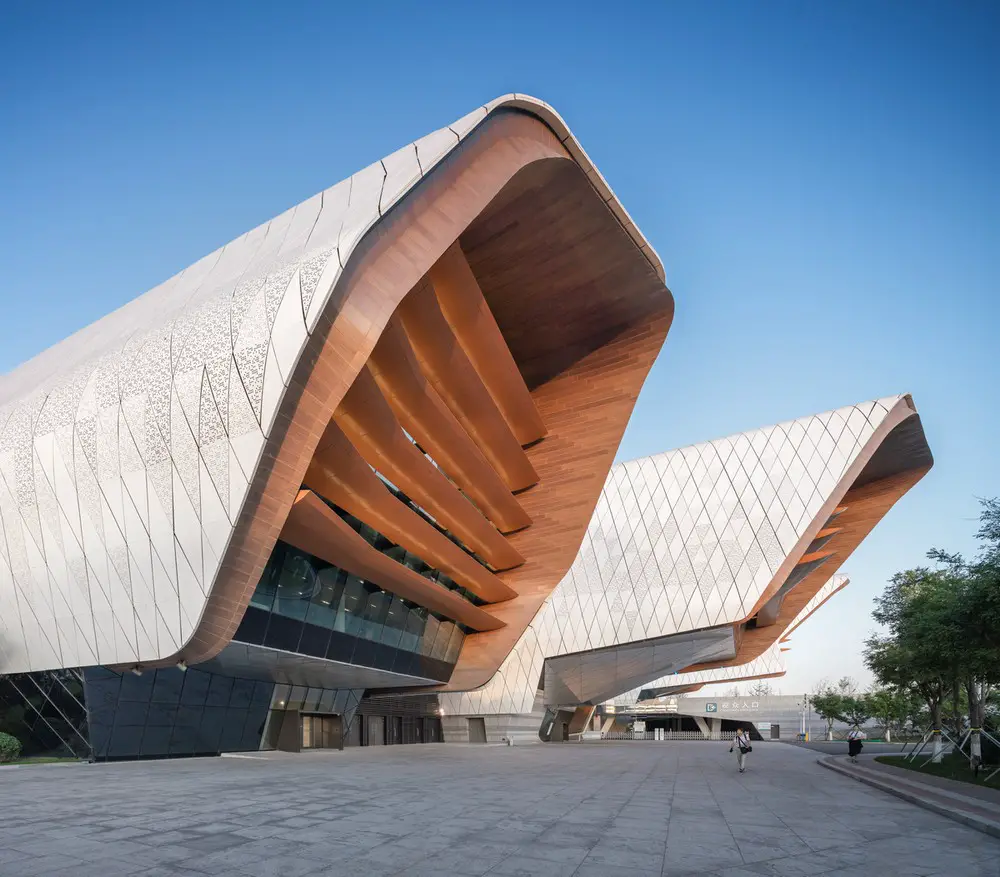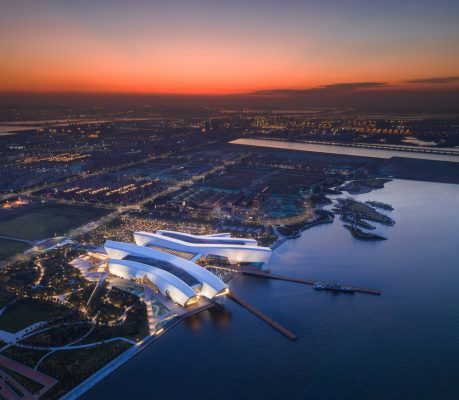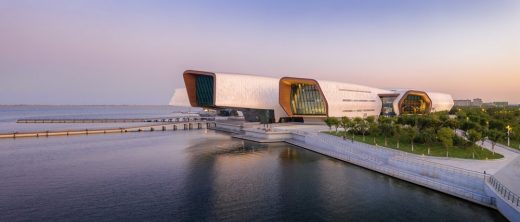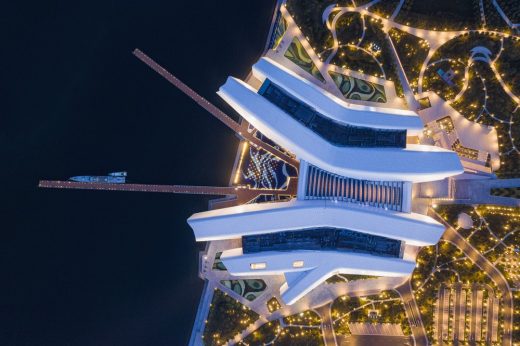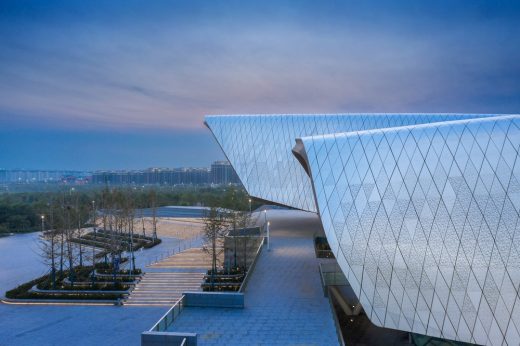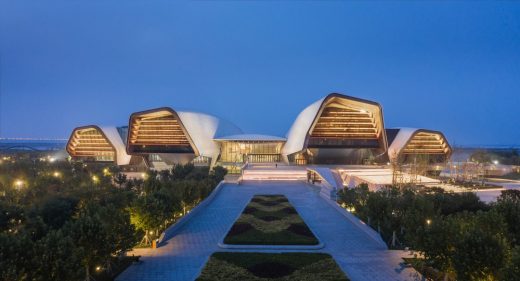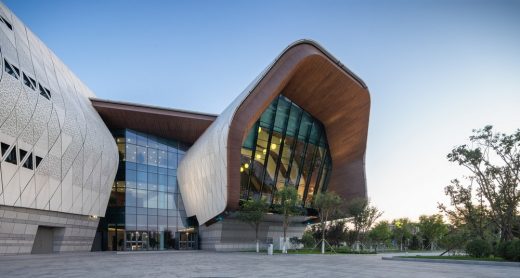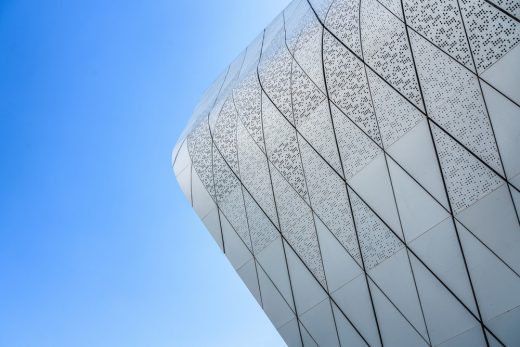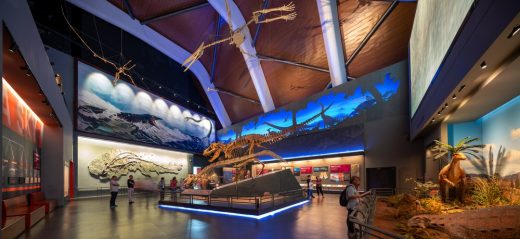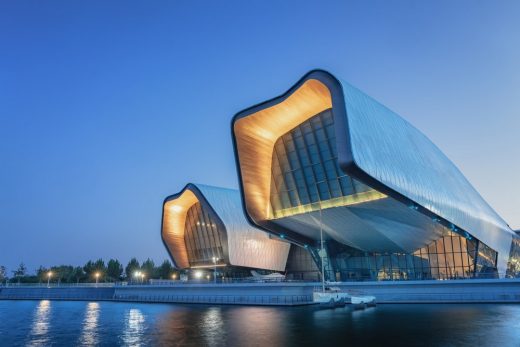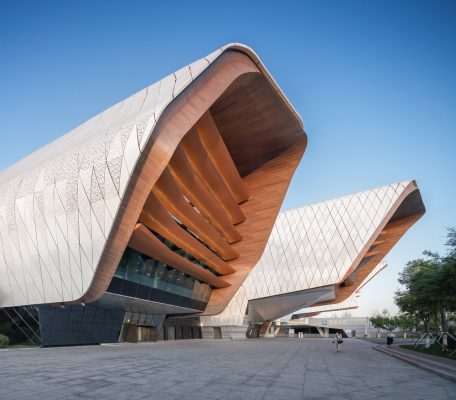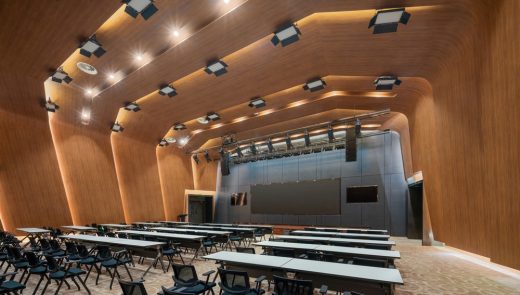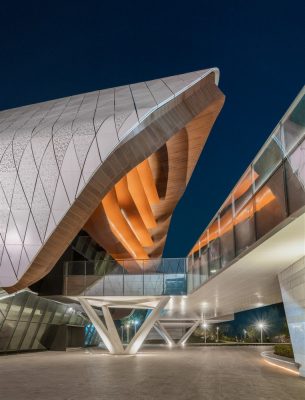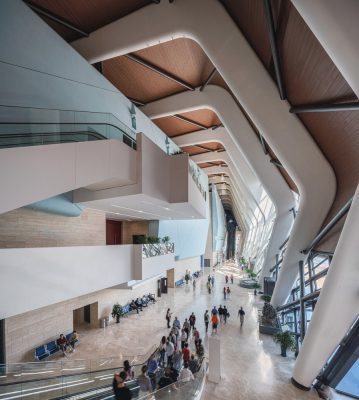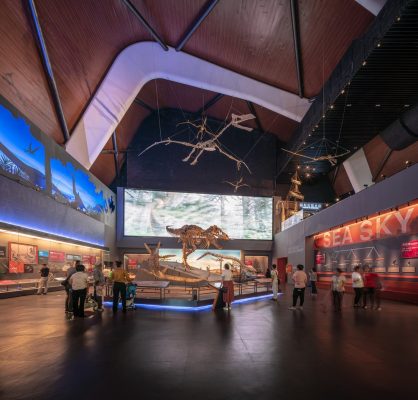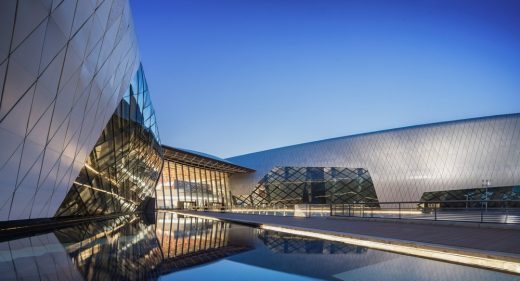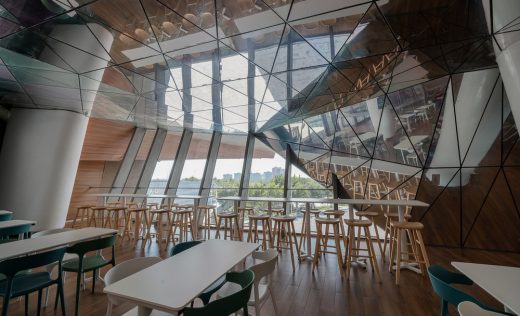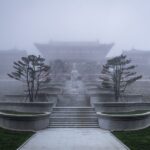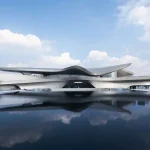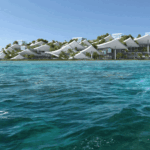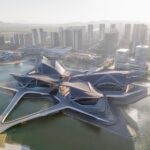National Maritime Museum, Chinese Architecture Project, Tianjin Building Development Photos
National Maritime Museum of China
9 Mar 2020
National Maritime Museum in Tianjin
Design: Cox Architecture
Location: Tianjin, China
Major new cultural landmark for China takes its place on the Global stage China’s first National Maritime Museum has now commenced formal operation, the culmination of a 6-year process which began with an international design competition, followed by an intensive design and construction process.
The Museum has a distinctive form which reaches out into the bay from a large waterfront parkland, behind which a new city district of Tianjin, called the Binhai New Area is currently being developed.
It is a landmark project comprising four wings, focusing on the themes of “the ancient ocean,” “ocean today,” “journey of discovery” and “the age of the dragon”. The three-storey museum, covering 80,000 square meters and containing six display areas and 15 exhibition halls. These halls are interconnected so that visitors are provided an opportunity to understand and interpret China’s maritime evolution in relation to events in Europe, America, and wider Asia.
COX Architecture was awarded the project in 2013 after winning an 8-month iterative design competition process involving multiple stages of client and stakeholder feedback. The building comprises a series of interconnected pavilions that cantilever out over the water in a ‘fan-like’ formation from a central reception hall. This central space is both for transition and exhibition and provides access to the upper of the two exhibition levels. On the lower level, stores for non-exhibited collections are co-located on-site to enable artefacts to be easily distributed to each of the adjacent exhibition spaces.
From Philip Cox’s initial watercolour sketches, the design evolved and certain compelling metaphors either resolved or emerged – jumping carp, corals, starfish, moored ships in port and an open palm reaching out from China to the maritime world. Without resorting to literal mimicry, some are more obviously expressed, such as in the geometric pattern and textures of the cladding, also functionally designed to shed heavy snow loads during harsh winters typical in this part of China.
The articulated pavilions provide a constant connection between inside and out. The user experience exists within the landscape and is a key organising device of the plan, helping to orientate visitors on their journey experience. During development of the design, both physical and digital modelling was carried out to test the building structure and many of the key details of the design.
This approach greatly improved the quality of outcomes and assisted communication beyond any language barriers. The process was innovative – especially for a project of this size, scale, complexity and location – in its deployment of parametric computer modelling that allowed both scale and detail to be resolved concurrently. Physical models focused on human scale and interaction while complex geometric algorithms resolved the doubly curved building ‘shell’ and its related cladding system.
Energy for the building is predominantly sourced via geothermal, being drawn from 100 metres below the building.
The museum held its soft opening in May 2019. Admitting up to 1,000 visitors a day while operations are refined and while exhibitions are fully installed. Full public operation is anticipated by in October.
Brendan Gaffney, National Director for COX, based in Brisbane said:
“The National Maritime Museum of China is justified in its ‘landmark’ status…it is a remarkable building borne of a remarkable process. It is a project that’s totally at home on the global stage. It is testament to the commitment of our open-minded and collaborative client and to our team, whose talent and tenacity in equal measure ensured this building stayed true to its vision in every possible detail.”
National Maritime Museum of China in Tianjin – Building Information
Architects: Cox Architecture
Project size: 80000 sqm
Site size: 150000 sqm
Completion date: 2019
Building levels: 3
Key Data and Anecdotes
150,000m2 of site, 80,000 GFA. Of that, 39,000m2 of exhibition.
Scale: When compared with the size of the Sydney Opera House the NMMC is two and a half times larger in terms of both length and site area.
55,000m2 of aluminium façade, 3,500m2 of glazed façade. The façade thickness is 828mm to accommodate the aluminium façade, the rain screen, the standing seam, the insulation, the interior lining and any substructure within that.
17,000 tonnes of steel for the primary structure alone, not including the secondary structure.
The largest structural cantilever is almost 42 metres in length.
One of the challenges we had was that because this building is curved there’s no defined wall and ceiling. This was a challenge because building Codes in China refer to walls having B-grade fire rating and ceilings that should have a higher, A-grade rating. Because of the curvature it wasn’t possible to define where the walls stopped and the ceiling started, so everything had to be the highest grade in fire rating.
The project was a massive team effort in terms of time. We’ve calculated that it’s equivalent to one person working continually for 11.6 years on this single project.
Technology and ESD
Revit, Rhino and BIM played a huge role in coordinating and delivering thus project. It resulted in the biggest digital model we’ve ever worked with.
The solution includes giant seismic portals, each resting on massive ball joints that are designed to move when there’s seismic disruption in the landscape.
There is syphonic drainage built literally into the ‘skin’ of the building. This was very difficult to achieve because the building’s organic form (as opposed to being flat). This drainage captures grey water for future use on site on the dry months.
The roof is arrayed with high efficiency solar panels in a ‘solar farm’. This, in addition to thermal underground heating warms the building during the harsh Tianjin winter and on cooler days.
Cox Team
Hang Ling, Alex Leese, Jack Dodgson, Ashley Beckett, Jayson Blight, Jaegeun Lim, Alex Munoz, Michael Bailey, Philip Cox, Lei Li, Leon McBride, Troy Rafton, James Ryan, Mitchell Page, Julian Farrell, Andrew Butler, Belinda Williamson, David Reasbeck, Ayo Akinola, Mark Sierzcula, Perry Gustafson, Kim Huat Tan, Spyros Barberis, Megan McKenzie, Gary McFeat, William Gray, Michael Rayner, Adrian Taylor, Roger Mai, Joseph Hartley, Karen Appleyard, Matthew Napper, Brendan Gaffney, Katy Roberts, Katie Holzberger, Mark Hadfield, Maxie Navius, Jaclyn Sun, Casey Vallance, Marianella Picon, Robert Callanan, Martin Hayes, Tae Won Kang, Solomon Romion, Brendan Kenny, Vesna Lazarevic, Steve Hunter, Thomas Nelson, James Sia, Tracey Maree, Akiko Spencer, Joachim Clauss, Tim Morgan, Brett Miles, Tommy Miller, Anya Meng.
Client: National Maritime Museum Preparatory Office Chinese Government and Tianjin Municipality
Local Design Institute Partner: Tianjin Architecture and Design Institute (TADI)
Key Consultants: Arup, Lord Cultural Resources, Urbantect
Awards to Date:
World Architecture Festival Future Project of the Year 2013
World Architecture Festival Future Cultural Project of the Year Award 2013
World Architecture Festival Competition Project of the Year Award 2013
Photography: Terrence Zhang
National Maritime Museum of China in Tianjin images / information received 090320
National Maritime Museum Tianjin Building
National Maritime Museum Tianjin Building – design competition entry by another architecture office
Location: Tianjin, China
Tianjin Architecture
Tianjin Architecture Designs
Four Seasons Hotel in Tianjin
Design: WATG, Architects
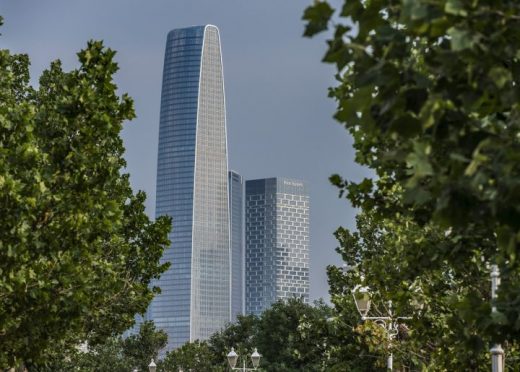
image courtesy of architects
Four Seasons Hotel in Tianjin
Riverside 66 Tianjin
Design: Kohn Pedersen Fox Associates
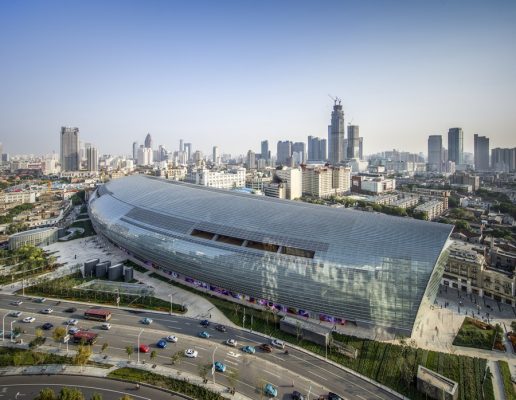
image courtesy of architects
Riverside 66 Tianjin Building
Tianjin National Convention and Exhibition Centre

image from architects
Tianjin National Convention and Exhibition Centre
Tianjin Binhai library facade
KDG group, INC
Tianjin Library Facade
Tianjin West Railway Station
von Gerkan, Marg and Partners Architects (gmp)
Tianjin West Railway Station
Tianjin R&F Guangdong Tower
Goettsch Partners
Tianjin R&F Guangdong Tower
Tianjin Xiqing District County Elementary School
Vector Architects
Tianjin Xiqing District County Elementary School
Vantone Center
AS+GG
Vantone Center
China Architecture
– chronological list
Chinese Architecture Offices – Design Practice Listings
Comments / photos for the National Maritime Museum of China in Tianjin page welcome

